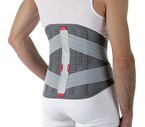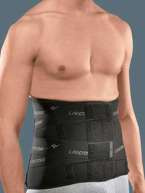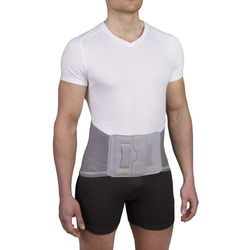Lower back braces & Lumbosacral support belts
( number of products: 123 )Lower back braces - benefits and uses
If you experience back pain, have recently undergone surgery or are treating degenerative changes in the vertebrae, a back brace would significantly improve your recovery process. Continue reading to learn if a lower back brace is right for you.
Lumbosacral back braces - who are they intended for?
As the name suggests, lumbosacral back braces are medical equipment intended for
rehabilitation. This type of orthosis helps to provide lumbar support and relieves lower back pain, as well as activates muscles of the lower back and supports the abdominal wall, thus improving body posture.
Depending on what the brace is intended for, it may have a number of benefits. Lower back braces may be recommended if you’ve recently undergone back surgery in the case of treating degenerative changes in the vertebrae, chronic low back pain, muscle tension and lower abdominal procedures.
Back braces may differ from one another, depending on their intended uses. Some models are meant to simply stabilize the spine in the lower back, whereas others may be designed for more complicated tasks. They may be equipped with chest straps, take the form of shorts or have varying lengths.Choosing the best back braces for treating your condition should be done so by a doctor or physiotherapist.
How do lumbar support braces work?
How back braces work depends largely on the type you choose. Almost every brace helps to relieve lower back pain and stabilize the spine in the lumbar region, while reducing lumbar lordosis and activating the abdominal muscles. Certain models also come equipped with additional back support options, such as complete stiffening and even a locking option, which is especially helpful for patients who have recently undergone lower back surgery.
Back braces are most often recommended for treating low back pain that may cause degenerative changes. Wearing a lumbar support for an extensive amount of time helps activate abdominal muscles, which improves body posture.
The types of lower back braces
As mentioned previously, back braces differ from one another with regards to their length and intended use. The lumbar support comes in various sizes, which can be adjusted using straps, once the wearer’s waist size has been measured and the manufacturer’s instructions have been carefully read. Back braces are also made of breathable materials that do not cause bruising or irritation.
Various back brace and orthopedic belt models have replaceable straps that allow the wearer to regulate the level of stability offered by the back support.Thanks to this, you can wear one brace throughout your entire rehabilitation period, regulating it your progress in recovery.
You can find the right size of back brace by measuring your waist, however, certain models have elastic straps and low back velcro fasteners that guarantee a good fit for people with larger waists. You can find such products in our store if you fall into this category.
Frequently asked questions - FAQ
How long should I wear a back brace?
The duration for wearing a back brace is determined by your doctor, as it depends on
the nature of your condition and its severity. You must also be aware that wearing a back support for too long can degenerate lower back muscles and will make regeneration difficult.
The brace should also be strong enough to keep you stabilized while bearing loads as well. A back brace must allow for tissues to shrink and stretch, and prolonged immobilization restricts this.
Therefore, it is best to wear the back brace during episodes of intense back pain or after
experiencing strenuous strains on the back (such as during sports).
What are the types of low back braces?
Back braces are subdivided into a number of variants, each of which serves its own purpose. Some models, such as lumbar-sacral braces or thoracolumbar-sacral braces are uniquely designed. Variants which come with lifting straps are primarily intended for injury prevention, rehabilitation and therapeutic use.
How to choose the right back brace?
Choosing the right sized back brace is similar to shopping for clothing - our sizes range from small and medium to large and extra large. Adjustable straps make it easy for the wearer to adjust the brace to fit comfortably. Detailed instructions can be found on the back brace packaging, however, if in doubt, ask a medical store employee for assistance.
When should I wear a back brace?
Bear in mind that a back brace acts as a support in treatmenting problems such as back pain, rehabilitation and the prevention of back problems. As such, a brace should not be treated as the basis for therapy. A back stabilizer is intended to reduce back pain and improve the comfort of everyday functioning, however, it does not cure the source of the ailment. Any severe lower back pain or other serious conditions that affect the musculoskeletal system should be consulted without delay with a specialist who will determine the appropriate course of treatment and decide if a back support will help.

Back stabilisation and relief of the lumbar spine Lumbo Direxa Stable 50R54 Ottobock

Back stabilisation for the lumbar & lower thoracic spine Lumbo Direxa High 50R52 Ottobock


















